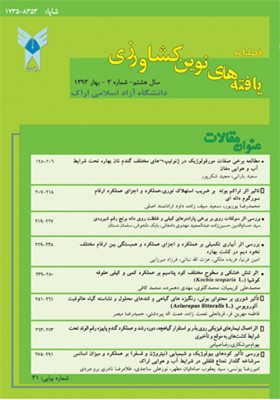بررسى تأثیر کودهاى بیولوژیک و شیمیایى نیتروژن و فسفر بر عملکرد و میزان اسانس سرشاخه گلدار نعناع فلفلى در شرایط آب و هوایى اراک
محورهای موضوعی : یافته های نوین کشاورزیامیررضا یونسی 1 , سید یعقوب صادقیان مطهر 2 , نورعلی ساجدی 3 , غلامرضا نادری بروجردی 4
1 - دانشجوی سابق کارشناسی ارشد زراعت دانشگاه آزاد اسلامی اراک
2 - استاد مؤسسه تحقیقات ثبت و گواهی بذر کرج
3 - عضو هیئت علمی دانشگاه آزاد اسلامی اراک
4 - عضو هیئت علمی دانشگاه آزاد اسلامی اراک
کلید واژه: عملکرد اسانس, باکتری های آزاد کننده فسفر, باکتری های تثبیت کننده نیتروژن, نعناع فلفلی,
چکیده مقاله :
این آزمایش به صورت فاکتوریل بر اساس طرح بلوک های کامل تصادفی با چهار تکرار و دو تیمار نیتروژن در سه سطح شامل کود بیولوژیک سوپرنیتروپلاس (حاویباکتریهایAzospirillum، کنترلکنندهعواملبیماریزایخاکزی(Bacillus subtilis)و باکتریمحرکرشد (Pseudomonas fluorescens)، کود بیولوژیک نیتروکسین (حاویغلظتهایمختلفازباکتریهای Azospirillum/ Azotobacter) و کود شیمیایی اوره (kg/ha300) و نیز فسفر در سه سطح کود بیولوزیک بارور-2(حاوی باکتری های آزاد کننده فسفر) به همراه فسفات آمونیوم (kg/ha 125)، کود بیولوژیک فسفر و کودشیمیایی فسفات آمونیوم(kg/ha 250) طی سال زراعی 1387 در مزرعه تحقیقاتی دانشگاه آزاد اسلامی اراک اجرا گردید. نتایج آزمایش نشان داد که کود بیولوژیک سوپرنیتروپلاس و سپس نیتروکسین سبب افزایش قابل توجه وزن تر و خشک سرشاخه و نیز درصد وعملکرد اسانس سرشاخه گردید. تیمار تلفیقی کود بیولوژیک فسفر و فسفات آمونیوم بر مقدار صفت عملکرد اسانس سرشاخه و تیمار فسفر صفت میزان اسانس سرشاخه را تحت تأثیر معنی دار قرار دادند. تیمار تلفیقی سوپرنیتروپلاس و فسفر صفت وزن تر سرشاخه، را به طور معنی داری تحت تأثیر قرار داد. به طور کلی کودهای بیولوژیک حاوی باکتری های تثبیت کننده نیتروژن را می توان جانشین کودهای شیمیایی نمود و خصوصیات رشدی و عملکرد اسانس گیاه نعناع فلفلی را افزایش داد. در ضمن با مصرف باکتری های آزاد کننده فسفر می توان مصرف کود فسفر را تا 50 % کاهش داد بدون اینکه در خصوصیات رشدی و عملکرد اسانس کاهش معنی داری ایجاد شود. به نظر می رسد که یک برنامه زراعی دراز مدت که عوامل خاکی، کودی، محیطی و آبی را مورد توجه قرار می دهد در یک تناوب زراعی اصولی بتواند تأثیر بیشتری در افزایش عملکرد ماده مؤثره گیاهان دارویی از جمله نعناع فلفلی وجود داشته باشد.
Peppermint is an important medical plant which contains essential oil that has many usages in different industry. Nitrogen and phosphor are considered to be the most limiting factors of the plants' growth after the factor of water. Chemical fertilizers which are so much used to remove the shortage of these two elements have destructive environmental effects and reduce the quality of crops. Today, using biological fertilizers are considered to be the most suitable strategy to prevent the dangers of chemical fertilizers. This experiment was carried out in the form of factorial based on the Complete Randomized Block Design with four repetitions and two treatments, one of which is Nitrogen fertilizer including three levels of Super Nitro Plus biological fertilizer containing bacteria such as Azospirillum which controls the path of the soil-organisms' genetic factors (Basillus sp) and PGPR, plant growth provocative (Pseudomonas flurescens ), Nitroxin biological fertilizer containing different doses of Azospirillum bacteria, and Urea chemical fertilizer (300 kg/ha) and also phosphor fertilizer in three levels of Barvar II biological fertilizer containing phosphor releasing bacteria accompanying with Ammonium de phosphate fertilizer (125 kg/ha), Barvar II biological fertilizer and Ammonium de phosphate chemical fertilizer (250 kg/ha) in the agronomical year 1387 in the researching farm of Islamic Azad University of Arak. The results of the mentioned experiment demonstrated that the Super Nitro Plus biological fertilizer and in the second place, Nitroxin cause the significant improvement of the fresh and dry weight of offshoot also amount and efficiency offshoot's essential oil. The combinational treatment of Barvar II and Ammonium de phosphate causes significant improvements of the essential oil efficiency of offshoot. The combinational treatment of Super Nitro Plus and Barvar II causes the significant improvement of offshoot's fresh weight. Also, decreasing the chemical phosphor fertilizer consumption up to fifty percent becomes possible through employing phosphor-releasing bacteria without any significant decline in the growth characteristics and plant essential oil efficiency.


